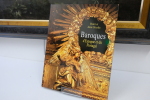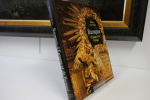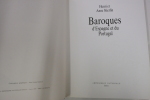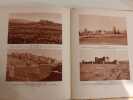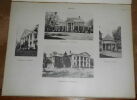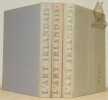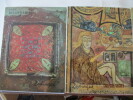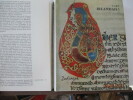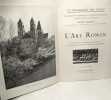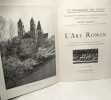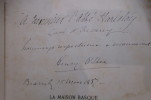-
Type
Any type (2)
Art print (7)
Book (32377)
Disk (1)
Drawings (7)
Engraving (9)
Magazine (129)
Old papers (1)
Photographs (14)
Posters (4)
-
Latest
Last 24h (4)
Last 3 days (127)
Last month (315)
Last week (14)
-
Language
Dutch (1)
English (54)
French (32450)
German (6)
Italian (18)
Japanese (2)
Portuguese (9)
Spanish (11)
-
Century
16th (16)
17th (56)
18th (222)
19th (1611)
20th (10329)
21st (1953)
-
Countries
Belgium (9485)
Brazil (7)
Canada (108)
China (3)
Côte d'Ivoire (67)
Denmark (218)
France (19598)
Germany (1)
Greece (1)
Italy (37)
Switzerland (3026)
-
Syndicate
ALAC (99)
CLAM (42)
CLAQ (94)
CNE (3)
ILAB (10650)
NVVA (1161)
SLACES (1161)
SLAM (8122)
SNCAO (9)
Monuments de l'Antiquit
, Gallimard 2005, 2005 186 pages, 120 ill., sous couverture illustr e, 264 x 198 mm, cartonn . ISBN 9782742416189.
Ce volume, consacr aux Monuments de l'Antiquit , est comme un tour du monde en vol plan au-dessus des plus beaux t moignages des civilisations anciennes, parmi lesquels : le n olithique avec les m galithes de Stonehenge, l' gypte avec les Pyramides ou le temple de Karnak, la Gr ce avec l'Acropole ou les temples de Paestum, le Moyen-Orient avec la Pers polis des Grands Rois perses ou Palmyre, la cit du d sert, Rome avec le Colis e ou l'aqueduc du Pont du Gard, le monde bouddhique avec la citadelle de Jiaohe ou le grand st pa de Borobudur, l' re pr colombienne avec Teotihuac n la myst rieuse.
Palais, villas & ch teaux
, Gallimard 2007, 2007 182 pages, ill., sous couverture illustr e, 260 x 200 mm, cartonn . ISBN 9782742420551.
Ce quatri me volume de la collection Notre histoire lue du ciel , consacr aux Palais, Villas et Ch teaux, est un voyage au-dessus des plus belles demeures de tous les temps : l'Italie antique avec la villa d'Hadrien, le monde musulman avec l'Alhambra maure ou le palais de Topkapi, la Chine avec la Cit interdite et le Japon avec le palais imp rial de Tokyo, l'Europe de la Renaissance au baroque avec le palais de Charles Quint Grenade, Versailles, le ch teau de Sans-Souci, le palais d' t de Tsarsko e Selo, l'Inde des maharajas avec Uda pur, les pastiches du XIXe si cle avec Neuschwanstein ou Pena, l'architecture contemporaine avec le Palais Bulles sur la C te-d'Azur ou le palais de la Vraie Lumi re du sultan de Brunei.
Tr sors de l'art en Egypte
, Biblioth que des arts 1994, 1994 Hardcover , 278 pages, Texte en Francais, 395 x 275 mm, Tres belle exemplaire , sous le jacquette !!. ISBN 9782850472442.
Baroques d'Espagne et du Portugal
Relié, 198 pages, illustré en couleur en parfait état, avec une jaquette en carton.
Kasbas berbères de l'Atlas et des Oasis - Les Grandes architectures du Sud marocain
Paris Horizons de France 1938 24 x 28 cm Reliure demi-toile à bande, couverture illustrée conservée 144 pp Nombreuses illustrations : photographies sépia de l'auteur, dessins originaux de Théophile-Jean Delaye. Plusieurs planches de motifs décoratifs en fin d'ouvrage.
Très bon état Photos de tous nos ouvrages sur demande
Henri Van Daele ; Paul van Wouwe ; translation : Anne-Laure Vignaux
Reference : 62037
dynastie belge a travers les timbres-poste
, Racine Lannoo, 2003 Hardcover, 128 pages, Texte en Francais, 300 x 220 x 17 mm, beaucoup illustr. en couleur / n/b, bon etat. ISBN 9782873863326.
Le XIXe si cle marque la perc e du timbre-poste. Apr s que le Britannique Rowland Hill ait invent en 1837 le syst me par lequel l'exp diteur et non plus le destinataire paie l'envoi, le premier timbre au monde fait son apparition au Royaume-Uni en 1840 : le Penny Black. Le premier timbre belge a suivi en 1849. Initialement, la variation devait tre limit e : par exemple, aucun nouveau dessin n'a t introduit. De plus, ils se sont limit s trois sujets : initialement uniquement le roi, plus tard le lion belge et vers la fin du XIXe si cle galement les armoiries belges. Timbre belge de 1893 avec bande du dimanche. Le sujet du timbre est le blason belge. Timbre belge de 1893 avec bande du dimanche. Le sujet du timbre est le blason belge. Timbre belge de 1905 avec bande du dimanche. L'image est celle du roi L opold II. Timbre belge de 1905 avec bande du dimanche. L'image est celle du roi L opold II. Apr s le premier timbre belge, le type Epaulettes, apparu en 1849, un nouveau type l'effigie royale suivit dans les ann es 1850, savoir le type M daillons. En 1863, une variante de ce type appara t pour la premi re fois sous forme dent e. Avant cela, les timbres-poste taient simplement rectangulaires. Juste avant la mort du roi L opold Ier en 1865, un troisi me type a t publi , dans lequel le premier monarque de Belgique tait repr sent en vue de c t . En 1866, le premier timbre est apparu qui n'avait pas une image du roi, mais celle d'un lion belge. Les premi res missions l'effigie du roi L opold II suivirent en 1869. A cette poque, il tait d j roi depuis plusieurs ann es : il avait d j pr t le serment constitutionnel le 17 d cembre 1865. Un nouveau monarque n' tait pas la seule nouveaut sur les timbres partir de 1869 : d sormais le mot BELGIQUE est mentionn sur les timbres. Le terme POSTES tait galement r guli rement ajout l'inscription. Le nom du pays n' tait mentionn qu'en fran ais. Le 1er juillet 1891, le premier timbre bilingue est apparu, avec le nom du pays en fran ais et en n erlandais sur les timbres. Les mots n erlandais BELGIUM et POSTERIJEN ont t ajout s l'inscription. La m me ann e apparaissent les premiers timbres t l phoniques belges, imm diatement bilingues.
"Résidences et Plantations dans les vallées de l'Ohio et du Mississipi au début du 19 ème siècle"
"1948. Paris Éditions Vincent & Fréal 1948 - Broché 25 cm x 33 cm 2 pages+32 - Texte et plans de Henri Walbert - Dos fendu sinon bon état intérieur"
LA SAVOIE D'AIX LES BAINS A LA VANOISE
Cahiers Henri Ferrand n° 5, sous le patronage du Club Alpin Français, La Manufacture , collection « Architecture et patrimoine en montagne ». Réimpression de l'édition originale de 1907 augmentée des présentations de pierre Truchet et Chardonnet et d'une bio-bibliographie de l'auteur par paul Hamon. In-4°, couverture souple illustrée, en très bon état.
ray AA3*
L'OISANS ET LES ECRINS
Cahiers Henri Ferrand n° 4, sous le patronage du Club Alpin Français, La Manufacture , collection « Architecture et patrimoine en montagne ». Réimpression de l'édition originale de 1903 In-4°, couverture souple illustrée, en très bon état.
ray AA3*
L' ART IRLANDAIS. tome 2
Zodiaque "La Nuit des Temps" volume 19, 1964. In-8 carré relié toile éditeur avec jaquette et étui de carton gris, 305 pages; abondamment illustré de belles photographies inédites de P. BELZEAUX .
La librairie fermera ses portes en 2025. Des remises de 25 à 50 % peuvent s'appliquer au cas par cas.
L' ART IRLANDAIS. tome 3
Zodiaque "La Nuit des Temps" volume 20, 1964. In-8 carré relié toile éditeur avec jaquette et étui de carton gris, 303 pages; abondamment illustré de belles photographies inédites de P. BELZEAUX .
La librairie fermera ses portes en 2025. Des remises de 25 à 50 % peuvent s'appliquer au cas par cas.
L'art irlandais.
La Pierre-Qui-Vire, Zodiaque (La nuit des Temps), 1964 ; in-8. 1f.-305pp.-2ff. - 8ff. in-texte d'illustrations en couleur, 120 planches in-texte illustrées en noir. Cartes, plans et croquis in-texte. Pleine toile rose d'éditeur. Jaquette couleur. Très bon état.
Deuxième tome d'une série de trois volumes.
L’Art Irlandais I, II et III. Photographies inédites de Pierre Belzeaux. Collection: La nuit des temps, nos. 18, 19 et 20.
La Pierre-qui-Vire (Yonne), Zodiaque 1963 - 1964, 220x180mm, 308 + 305 + 303pages, reliure toile d'éditeur. Bords du dos du plat inférieur du tome II insolé, autrement bel exemplaire.
336 photos en héliogravure, 42 planches en couleurs, et 3xVIII soit 24 planches documentaires en n/b, Pour un paiement via PayPal, veuillez nous en faire la demande et nous vous enverrons une facture PayPal
L’art Irlandais III. Photographies inédites de Pierre Belzeaux. Collection: la nuit des temps, n.° 20.
La Pierre-qui-Vire (Yonne), Zodiaque 1964, 220x175mm, 303pages, reliure d'éditeur sous jaquette. Comme neuf. Très bel exemplaire.
photos en héliogravure, planches en couleurs, et 8 planches documentaires en n/b, illustrations n/b in et hors texte: cartes, plans, croquis, Pour un paiement via PayPal, veuillez nous en faire la demande et nous vous enverrons une facture PayPal
L'Art irlandais - Volumes , I, II & III - L'art aux XI & XII siècles
1963 La Pierre-qui-Vire, Zodiaque, 1963, 1964 -Complet en 3 vol. pet. in-4 - Reliure toile éditeur avec jaquette illustrée en couleurs, sous emboîtage - Photographies en noir et en couleurs, certaines PP de Pierre BELZEAUX - Dessins in-texte de l'auteur- Signets - 307 pages & VIII Planches NB HT, 296 pages & 8 Planches HT & 294 pages & VIII Planches HT - Très bons exemplaires, Propres, à l'état de neuf - Envoi rapide et soigné
- Livraison a domicile (La Poste) ou sur simple demande en Mondial Relay.- ATTENTION: Colis recommandé uniquement sur demande (parcel recommended on request). Si vous désirez un remboursement équivalent au montant de votre achat, en cas de perte détérioration ou spoliation, demandez-nous expressément un envoi en recommandé ( if you wish a repayment equivalent to the amount of your purchase, in case of loss - deterioration or despoliation, ask us expressly for a sending recommended)- Conditions de vente : Les frais de port sont affichés à titre Indicatifs (pour un livre) Nous pouvons être amené à vous contacter pour vous signaler le surcoût du au nopmbre de livres achetés ou du poids de ceux-ci. - Conditions of sale : The shipping costs are displayed as an indication (for one book) We may need to contact you to inform you of the cost of the additional shipping depending on the weight and the number of books- Possibilité d'envoi par Mondial-Relay - Réception en boutique sur rendez-vous. Librairie G. PORCHEROT - SP.Rance - 0681233148
LE MONT SAINT-MICHEL ET SA BAIE
PML. 1984. In-4. Relié. Bon état, Couv. convenable, Dos satisfaisant, Intérieur frais. 60 pages. Illustré de nombreuses photos en couleur. Etiquettes de code sur le dos et le 1er plat. Scotch au dos des plats. Annotations de bibliothèque en pages de garde et de titre. Range fichette en dernière page de garde.. . . . Classification Dewey : 720-Architecture
Merveille de l'Occident. L'histoire du Mont. La Visite... Classification Dewey : 720-Architecture
Une ville en projets Reims 1977-1982. Recherches, projets, réalisations
L’Equerre, coll. « Plan Construction » 1984 In-8 broché 25 cm sur 21. 123 pages. État correct d’occasion.
Postface de Jacques Lucan Etat correct d’occasion
Les STYLES
Un ouvrage de 187 pages, format 135 x 215 mm, 100 illustrations, relié percaline, s.d. (début du XXe siècle), Librairie Charles Delagrave (Paris), collection "Les Arts de l'Ameublement", bon état
Intéressant volume sur les différents styles architecturaux
Phone number : 04 74 33 45 19
Gustav Mahler, The Arduous Road to Vienna (1860-1897) Completed, Revised and Edited by Sybille Werner
, Brepols 2020, 2020 Hardcover, xvii + 809 pages., 58 b/w ills, English, 210 x 260 mm,. fine! ISBN 9782503588148.
The volume traces the life and career of Mahler from his birth to his appointment to the Vienna Hofoper. This long awaited revised volume I completes Henry-Louis de La Grange's four-volume English language biography of the Austrian composer Gustav Mahler (1860?1911), which is widely considered to be the definitive work on the subject. The present instalment, covering the years 1860 to 1897, traces the life and career of Mahler from his birth in a small village in Bohemia to his appointment to the Vienna Hofoper, then the most prestigious opera house in the world. It describes his family background, his student days at the Vienna Conservatory, his private life, and his burgeoning career as both conductor and composer. Starting at a small summer theatre in Bad Hall, his first engagements took him to Laibach (Ljubljana), Olm tz (Olomouc), Kassel, Prague, and Leipzig, before he was appointed to principal posts at the important opera houses of Budapest (1888) and Hamburg (1891). By now Mahler had also begun to establish himself as a composer. Some of his major works ? starting with Das Klagende Lied (1881) ? the early Wunderhorn songs, Lieder eines fahrenden Gesellen , and the first three symphonies date from this period of his life. While regularly rejected by contemporary critics, today they are favourites of the concert repertoire. Widely recognised as Gustav Mahler's pre-eminent biographer, Henry-Louis de La Grange (1924?2017) ? author of the 4-volume, 5,000-page definitive study of the composer's life and work ? was awarded a professorship by the government of Austria and an honorary Doctorate from the Juilliard School of Music. He lectured extensively, organised concerts, exhibitions, and music festivals, and contributed to film documentaries and radio features. Together with Maurice Fleuret he founded the M diath que Musicale Mahler in Paris. German musicologist and conductor Sybille Werner started working with Henry-Louis de La Grange in 2003. She has repeatedly lectured and published on the performance history of Mahler's works, and in 2018 received the Mahler Award of the Sociedad Mahler Mexico. Her conducting activities have taken her beyond New York, her former residence, and the USA to Germany, Italy, Japan, Mexico, Poland, and the UK. Currently she is based in Toblach and associated with the Gustav Mahler Music Weeks.
Ritual Figures in Congo
, Rizzoli, 2024 hardcover 224 pages Illustrated.27.9 x 24.1cm Text in ENG. - FINE. ISBN 9788891839053.
A sophisticated publication dedicated to one of the most astonishing collections of African art. This book presents a variety of ritual figures from the Democratic Republic of Congo. Figurative sculpture is considered the best expression of African ritual arts and was one of the most important sources of inspiration for early twentieth-century artists, leaving a deep impact in the world history of art. Produced in different materials, from wood to stone and ivory, figurative sculpture has been produced
Art roman grammaire styles
Flammarion 1965 in8. 1965. Broché.
couverture défraîchie intérieur propre
La Renaissance française - 67 illustrations
Librairie Ernest Flammarion 1944 63 pages in8. 1944. broché. 63 pages. Ouvrage de référence illustré sur la Renaissance française publié dans la collection 'La Grammaire des Styles' des éditions Flammarion. Il propose un panorama complet de l'art de cette période à travers architecture mobilier peinture et sculpture avec de nombreuses illustrations en noir et blanc
Bon état
LA MAISON BASQUE. Notes et Impressions.
1887 / 86 pages. Broché. Editions Léon Ribaut.
Couverture frottée, dos absent, livre déboité, intérieur frais malgré la présence de très rares rousseurs. Etat convenable.
LA MAISON BASQUE. Notes et Impressions. (avec un envoi de l'Auteur)
1887 / 80 pages. Broché. Editions Léon Ribaut.
Couverture piquée, dos absent, intérieur présentant des rousseurs plus ou moins éparses selon les pages. Etat convenable.
 Write to the booksellers
Write to the booksellers